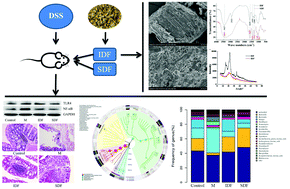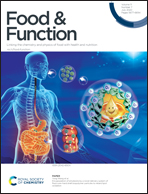Soy hull dietary fiber alleviates inflammation in BALB/C mice by modulating the gut microbiota and suppressing the TLR-4/NF-κB signaling pathway
Abstract
The present study is undertaken to assess the ability of insoluble dietary fiber (IDF) and soluble dietary fiber (SDF) extracted from soy hulls to relieve colitis in dextran sulfate sodium (DSS) induced inflammatory bowel disease (IBD) in a BALB/C mouse model. We characterized dietary fiber (DF) structures by scanning electron microscopy (SEM), Fourier-transform infrared spectroscopy (FTIR), and X-ray diffraction (XRD). Water retention capacity (WRC), water swelling capacity (WSC), oil adsorption capacity (OAC), glucose adsorption capacity (GAC), and the bile acid retardation index (BRI) were measured. The unique surface and chemical structural characteristics endowed DF with good absorption capacity and hydration ability, along with delayed glucose diffusion and absorption of bile acids. IBD was induced with a solution containing 5% DSS in male mice, which were administered a total oral dose of IDF (300 mg kg−1) and SDF (300 mg kg−1) three times per day after successful model establishment. All the mice were assessed weekly for weight change, diarrhea index, and fecal bleeding index. Levels of TLR-4 and NF-κB proteins were measured with western blotting analysis. Cytokine TNF-α in the serum was detected with an enzyme-linked immunosorbent assay (ELISA). Histological methods (H&E) were used to observe part of the mouse colon. The gut microbiota in the colonic contents was analyzed by 16S rRNA gene sequencing. DF decreased weight loss, diarrhea, and fecal bleeding, and also slowed serum TNF-α release. Increases in the levels of NF-κB proteins in inflamed colon tissue were also significantly suppressed by DF treatment. DF ameliorates the colitis induced decrease in gut microbiota species richness. The effect of SDF seemed clearer: the relative abundance of Barnesiella, Lactobacillus, Ruminococcus and Flavonifractor at the genus level was greater than that in the normal control group.



 Please wait while we load your content...
Please wait while we load your content...